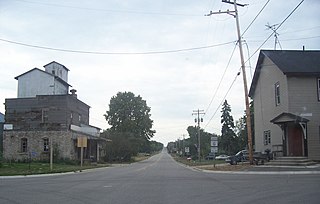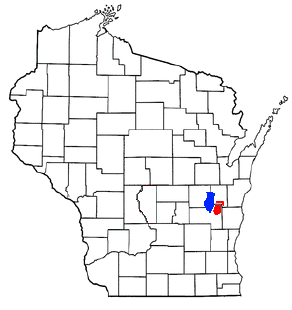
Calumet County is a county located in the U.S. state of Wisconsin. As of the 2020 census, the population was 52,442. The county seat is Chilton. The county was created in 1836 and organized in 1850.

Brothertown is a town in Calumet County in the U.S. state of Wisconsin. The population was 1,329 at the 2010 census. The unincorporated communities of Brothertown, Charlesburg, Eckers Lakeland, Jericho, and Maple Heights are located in the town. The unincorporated community of Calumetville is also located partially in the town.
Manchester is the name of places in the U.S. state of Wisconsin:
Jericho is a city, populated since ancient times, in the West Bank, Palestine.
Calumet County, Wisconsin maintains three county parks Calumet County Park, Becker's Lake Park and Ledge View Nature Center and Brothertown and Stockbridge harbors. The Stockbridge harbor is on the List of Registered Historic Places in Wisconsin. Calumet County Park is under the Calumet County Park Group, an archeological site listed on the National Register of Historic Places. Ledge View Nature Center has a nature center which explains the geology of the area.
The Brothertown Indians, located in Wisconsin, are a Native American tribe formed in the late 18th century from communities of so-called "praying Indians", descended from Christianized Pequot, Narragansett, Montauk, Tunxis, Niantic, and Mohegan (Algonquian-speaking) tribes of southern New England and eastern Long Island, New York. In the 1780s after the American Revolutionary War, they migrated from New England into New York state, where they accepted land from the Iroquois Oneida Nation in Oneida County.

State Trunk Highway 55 is a state highway in Wisconsin, United States. It travels south-to-north in the northeastern part of Wisconsin from an intersection with U.S. Route 151 (US 151) approximately 1.5 miles (2.4 km) north of Brothertown, near the eastern shore of Lake Winnebago in Calumet County, to the Michigan state line at the Brule River approximately one mile (1.6 km) northeast of Nelma in Forest County, where it connects to M-73.

Marytown, Wisconsin is an unincorporated community in Fond du Lac County, Wisconsin, in the town of Calumet. Marytown is located at the intersection of Fond du Lac County highways G and HH. Wisconsin Highway 149 ran north to south through the community before it was decommissioned in 2006.

Calumetville is an unincorporated community that straddles the county line between Calumet and Fond du Lac counties in Wisconsin. The main part of the community in Fond du Lac County lies in the town of Calumet, and the part in Calumet County lies in the town of Brothertown.

St. Anna is an unincorporated community in Calumet and Sheboygan Counties in the U.S. state of Wisconsin. It lies in the towns of Russell and New Holstein.

The Holyland is an American region located mainly in northeastern Fond du Lac County, Wisconsin and southern Calumet County. The area is known for its distinctive agricultural landscape, a close-knit community life, and deep Roman Catholicism brought by Germans who first settled the region in the 1840s. The area has been studied as an example of chain migration. It has been called "The Holyland" since at least 1898.

Charlesburg is an unincorporated community in the town of Brothertown in Calumet County, Wisconsin, United States.

St. Peter, Wisconsin is an unincorporated census-designated place in the Town of Taycheedah in Fond du Lac County, Wisconsin. It is located approximately 2 miles (3.2 km) northeast of Peebles and 1 mile (1.6 km) south of Silica. It was located on Wisconsin Highway 149 before the highway was decommissioned and turned over to county control as County Highway WH. As of the 2010 census, its population is 1,489.

Brothertown is an unincorporated community located in the town of Brothertown, Calumet County, Wisconsin, United States.
William Fowler was a Native American politician and the first non-white legislator in Wisconsin. He served in the 1845 session of the Legislative Assembly of the Wisconsin Territory, representing Calumet County and other northeastern counties, and was later treasurer of Calumet County. During the American Civil War, he volunteered for service in the Union Army and died of wounds he received at the Battle of Perryville in 1862.
Joshua Hayward Haight was an American merchant from Brothertown, Wisconsin who served one term as a Greenback Party member of the Wisconsin State Assembly from Calumet County, Wisconsin.

Thomas Commuck was an American composer and historian. His 1845 collection Indian Melodies has been described as the first published musical work by a Native American.
Alonzo David Dick was a Brothertown Indian farmer, tavernkeeper, and postmaster from Brothertown, Wisconsin,. As a member of the Whig Party, he served one term in the Wisconsin State Assembly, representing Calumet County.
William H. Dick was a Brothertown Indian farmer, carpenter and politician who served two terms, 20 years apart, in the Wisconsin State Assembly.
James W. Parkinson was an American farmer, politician, and Wisconsin pioneer. He served one term in the Wisconsin State Assembly, representing Calumet County during the 1880 session.
















